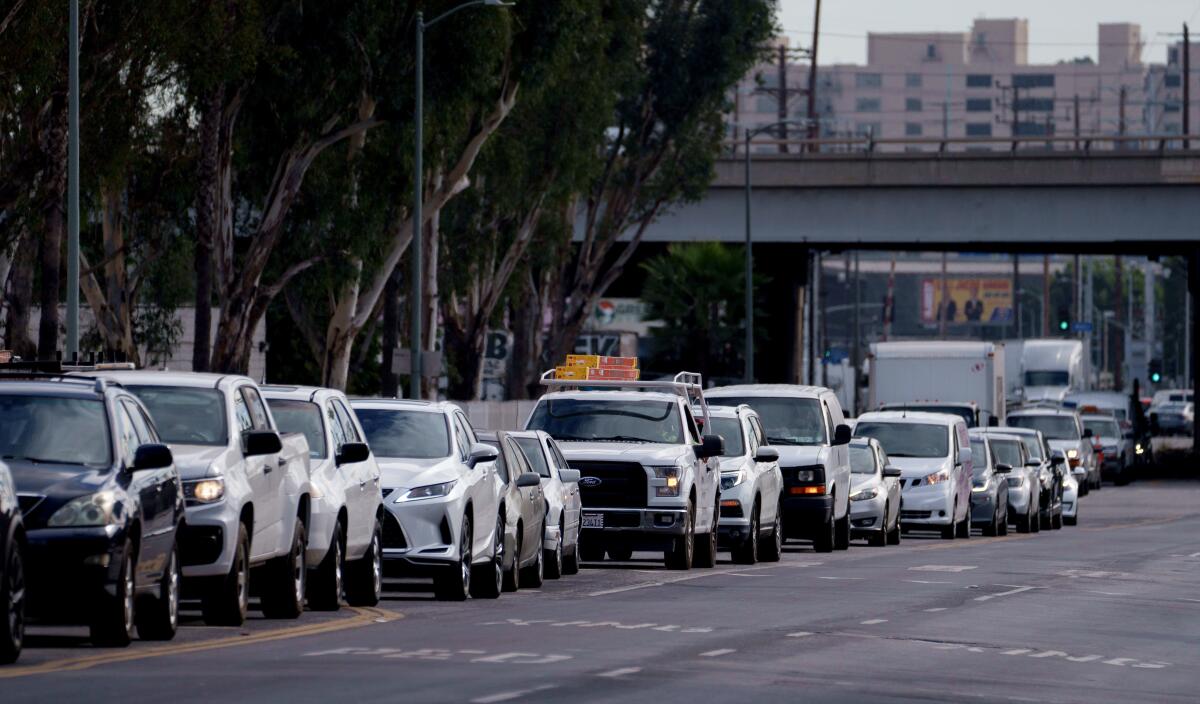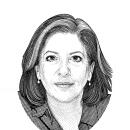Column: What Los Angeles freeways, and fires underneath them, teach us about ourselves

- Share via
Once upon a time, as the saying goes, there were two institutions that reliably connected the vast and varied corners of Los Angeles: The Times and the freeways.
The Times, of course, has struggled in well-publicized ways to retain its reach and influence, but the freeways still unquestionably provide a kind of civic glue.
Which is paradoxical, of course, because the construction of freeways has always also meant the bisecting of neighborhoods they displace. That which connects us, ironically, also isolates us. I know a Santa Monica native who left Southern California because she felt her beloved city was ruined after the 10 Freeway, which opened in 1966, sliced it in two.
Freeways play an outsized role in the life of an unwalkable, car-obsessed city like Los Angeles. When one goes down, the ripples are felt far and wide.
The fire that broke out on Nov. 11 under the elevated Interstate 10 in downtown Los Angeles forced the closure of a heavily traveled, mile-long stretch of the road, pushing thousands of cars and trucks into the surrounding working-class neighborhoods of Boyle Heights.
We can learn a lot about ourselves when a freeway is suddenly out of commission.
One revelation, thanks to reporting by my colleagues Rachel Uranga, Matt Hamilton and Ruben Vives, is that the vast stretches of land that sit below our elevated freeways are ripe for exploitation. Unscrupulous private landlords may lease public plots from Caltrans, then illegally sublet pieces of them at inflated rents to immigrant businesses whose owners are uninsured. Many a livelihood went up in flames when the fire, believed to be arson, broke out.
On Thursday, wanting to witness the effects of the freeway closure, I took what ended up being a 2½-hour drive from Venice Beach to Boyle Heights and back. The trip took about an hour longer than it would have under normal conditions, but when you slow down, you see all sorts of things you might otherwise have missed. What I saw was the best and worst of L.A.
I happily sailed east along the 10, the Hollywood sign on my left, the towers of the city skyline looming ahead under painterly clouds. Approaching the Convention Center, the left two lanes toward downtown became a parking lot, as drivers positioned themselves to transition to the 110.
I stayed right, in the nearly empty lanes, and gunned it till I got to the closed section. I exited the 10 at Alameda Street. And then the gridlock began.
I wound through depressing homeless encampments and gritty trash-strewn alleyways. It took 10 minutes to drive a few blocks on 7th Street, past the huge green expanse of the Boyle Heights Sports Center.
I inched along Whittier Boulevard toward the new, much ballyhooed 6th Street Viaduct, which, stunning as its arches are, looks like a public health hazard, its gentle curves practically inviting daredevil knuckleheads to climb it.
Later that day, Gov. Gavin Newsom and L.A. Mayor Karen Bass announced that the closed stretch of freeway had sustained less damage than originally believed and is expected to open by Tuesday. Blessedly, the formerly serene neighborhoods that have been besieged by long lines of slow-moving cars and trucks spewing exhaust will soon be back to normal. Well, their normal level of freeway-spawned pollution.
We love to catastrophize about traffic headaches — it’s in our civic DNA, after all — but what so often happens isn’t as bad as we thought it would be. The 10 fire traffic nightmare will soon become another chapter in the considerable lore of Los Angeles freeways.
If you’re like me and grew up around here, you will always think of the freeways by their names, not their numbers. For natives, the 10 will always be the Santa Monica Freeway. The 405 will always be the San Diego Freeway. The 101 is the Ventura Freeway in the Valley, and the Hollywood Freeway once you get to the Cahuenga Pass. The 110 is the Harbor Freeway until it becomes the Pasadena Freeway at its northern end. And, of course, the 5 is the Golden State.
Over the years, the freeways of Los Angeles have provided grist for many civic dramas, iconic moments and unrealized predictions of apocalyptic traffic jams.
In 1984, the last time this city hosted the Olympics, commuters were warned that the influx of visitors would result in Olympian traffic jams. Never happened.
In January 1994, the Northridge earthquake did wreak actual havoc, including, most spectacularly, on the 10 between La Cienega and Fairfax. The freeway buckled, but more dramatically, local news helicopter pilot Zoey Tur caught the breathtaking moment that a California Highway Patrol officer accidentally drove his cruiser over the abruption in the freeway and came to a halt when the car nosedived off the 5-foot ledge. He wasn’t hurt, and the way he throws up his arms in frustration and looks directly at Tur is why I never get tired of that video. (The freeway got fixed in a herculean hurry: less than three months. While it was being repaired, the detour gave drivers a delightful route reminiscent of Mr. Toad’s Wild Ride, as we twisted and curved along the frontage roads.)
Five months later, a handful of local freeways — the 5, the 91, the 110 and the 405 — starred in O.J. Simpson’s infamous slow-speed chase in his friend’s white Bronco, after he was charged with murdering his ex-wife and her friend. An estimated 95 million people watched that iconic car chase, which was also recorded by Tur.
Fast forward to 2011, when another freeway apocalypse, Carmageddon, was supposed to bedevil drivers after a 10-mile stretch of the 405 through the Sepulveda Pass closed for two days to accommodate the demolition of a bridge spanning the road. Never happened. As then-Supervisor Zev Yaroslavsky put it: “It’s dead as a doornail out there.”
In a few years, when the 2028 Summer Olympics come to town again for two weeks, just remember, Angelenos, there will be dire and entirely sincere predictions of unending traffic jams. When they fall flat as a pancaked overpass, please remember: I told you so.
More to Read
A cure for the common opinion
Get thought-provoking perspectives with our weekly newsletter.
You may occasionally receive promotional content from the Los Angeles Times.











